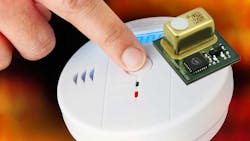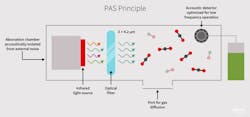Carbon-Dioxide Sensor Helps Reduce Risk of COVID-19 Transmission Indoors
What you’ll learn:
- Measuring indoor air quality is critical due to the COVID-19 pandemic.
- Existing CO2 sensors solutions on the market come with notable limitations that may harm performance.
- Advances in photoacoustic spectroscopy implemented in MEMS technology overcome many of the current CO2 drawbacks.
Since the beginning of the COVID-19 pandemic, scientists have gained a much better understanding of the virus’ primary routes of transmission. Research shows that the disease is spread primarily through close contact from one person to another, often in confined indoor spaces. This is an important consideration, as statistics from the U.S. Environmental Protection Agency (EPA) show that people spend 90% of their time indoors, where they’re likely to be at highest risk.
Effective monitoring of indoor air quality has thus become more critical than ever before. One of the most reliable measurement indicators of air quality is CO2 concentration. If a room is badly ventilated, CO2 concentration level starts to rise. As an example, in a poorly ventilated room measuring roughly 4 m2 containing a single individual, the CO2 value could go from 500 ppm (0.05%) to at least 1,000 ppm (0.1%) within 45 minutes.
Because CO2 is both a colorless and odorless gas, there’s no visual or olfactory indication that its concentration has increased. However, at heightened levels, it can start to cause uncomfortable physical symptoms such as headaches and drowsiness. From 2,000 ppm onward (0.2%), the cognitive abilities of humans can be impaired, and there’s a severe danger to one’s health at higher levels.
With regard to COVID-19, indoor CO2 concentration becomes a critical factor. As people exhale more CO2 in the air, they produce a high number of aerosols—tiny respiratory droplets or particles that can spread across a room. Numerous research papers show that aerosols linger for extended periods in poorly ventilated rooms, increasing the risk of long-range airborne transmission of the virus.
A study conducted by TU Berlin revealed that indoor climates play a significant role in health outcomes, as pathogens can be suspended in the air inside poorly ventilated rooms for long periods of time. As such, a frequent supply of fresh air is recommended as a means of reducing the chance of infection.
Drawbacks of Existing CO2 Sensors
With the understanding that lots of air containing CO2 could act as a COVID-19 transmission risk, there’s growing interest in the use of CO2 measuring solutions across a broad range of indoor locations, including gyms, bars, and restaurants. Yet while demand for gas-sensing technology is on the rise, some existing CO2 sensor solutions have notable limitations, which may harm performance.
For example, non-dispersive infrared (NDIR) CO2 sensors comprise a high number of internal components, such as an IR light source, a sample chamber, a spectral filter, and reference and absorption IR detectors. The resulting sensor is relatively bulky and costly.
A smaller and less expensive alternative is the estimated CO2 (eCO2) sensor. These devices use algorithms to calculate an equivalent CO2 value from known total volatile organic compounds concentration. The estimation is formulated on a set of assumptions rather than actual measurements, so this solution has its own drawbacks. Thus, the search continues for a compact and cost-effective sensor that provides accurate and true CO2 measurement.
Advances in Photoacoustic Spectroscopy
Leveraging its microelectromechanical-systems (MEMS) technology, Infineon developed a new CO2 sensor based on photoacoustic spectroscopy (PAS) that overcomes many of these drawbacks, making CO2 sensing technology suitable for a diverse spectrum of applications (Fig. 1). The technique is based on the principle that gas molecules absorb only light with a specific wavelength.
1. The Photoacoustic Spectroscopy (PAS) Principle is based on the precept that gas molecules absorb only light with a specific wavelength. For CO2, the wavelength is 4.2 µm.
For CO2, the wavelength is 4.2 µm. In terms of the detection process, light at this wavelength, generated via a pulsing infrared source with an optical filter, is passed through a sample of ambient air. This causes rapid heating and cooling, and thus thermal expansion and contraction of the target gas. It results in a pressure change that can be accurately recorded using an acoustic detector which is optimized for low frequencies. This signal is then analyzed to provide insight into the amount of CO2 in the air—the stronger the signal, the higher the CO2 concentration.
A highly sensitive MEMS microphone, which acts as a pressure sensor, is used to detect the gas, delivering advantages in terms of miniaturization. Other elements of the sensor are a photoacoustic transducer, infrared source, and optical filter. A microcontroller handles signal processing and a MOSFET powers the infrared source.
Infineon overcame major challenges to push the detector’s performance to its limits and reduce system noise to an absolute minimum. The MEMS detector is acoustically isolated from external noise by encapsulation; only the pressure change originating from the CO2 molecules in the chamber is detected. All components, including the isolated gas detection chamber and associated electronics, are integrated on a PCB. The absorption chamber is acoustically separated from external noise to ensure accurate CO2 sensing data. Otherwise, the function of CO2 detection would be significantly impaired.
According to Infineon, its XENSIV PAS CO2 sensor is the industry’s first real CO2 sensor based on the PAS principle (Fig. 2). The sensor benefits from an ultra-sensitive MEMS microphone, which can detect the pressure change created by CO2 molecules inside the sensor cavity without picking up external noise. As output, it delivers CO2 concentration in parts per million.
2. The XENSIV PAS CO2 is a real CO2 sensor in an unprecedented small form factor, enabled by the unique PAS detection principle.
Performance data has confirmed high-quality results even with the smallest pressure fluctuations. As a result, only the smallest amounts of gas are required for an ultra-precise determination, meaning the dimensions of the sample chamber could be made as small as possible.
The XENSIV PAS CO2 sensor is four times smaller (14 × 13.8 × 7.5 mm) and three times lighter at just two grams than typical NDIR sensors, allowing for more than 75% space savings in system designs.
CO2 Sensor for COVID-19 Management
The XENSIV PAS CO2 shows potential to help mitigate COVID-19 transmission. As the world tries to balance the need to control the spread of the disease with a requirement to reopen key infrastructure, sensing technology will be an increasingly important tool in effectively monitoring air quality and reducing aerosols in indoor environments.
Even before the pandemic began, the Federal Environment Agency of Germany and the American Society of Heating, Refrigeration, and Air Conditioning Engineers (ASHRAE) had published recommendations stating that the CO2 concentration should not exceed 1,000 ppm in classrooms and offices—as opposed to 400 ppm in open, fresh air.
With the understanding that a lot of air containing CO2 is exhaled wherever there is a high concentration of people in a room, the installation of CO2 measuring technology is likely to be extended to indoor settings with multiple people. Inexpensive and compact CO2 measuring devices promise to broaden the number of sites that could adopt sensor technologies to warn against high concentrations of CO2 in the air—and therefore correspondingly high levels of aerosols—providing a more readily accessible means of mitigating the spread the of the virus.
How might such equipment be used in practice in indoor environments? One solution could be the development of a CO2 sensing traffic-light system. In this application, networks of sensors could be connected to cloud solutions for data intelligence and remote access, and used to warn occupants of high CO2 and aerosol levels. The traffic-light system could give a clear signal to better ventilate individual rooms or specific areas in the building.
A Broad Range of Applications
In addition to controlling the risk of infection, data measured by CO2 sensors can be fed into intelligent building automation systems that control ventilation, known as demand-controlled ventilation (DCV). In such systems, CO2 measurements could be used for real-time adjustment of air mixtures in a room, automatically matching it to that of the air outside. This ensures that indoor CO2 concentration remains at an acceptable level, thus providing significant benefits in terms of comfort and well-being.
Effective air control in offices and homes also can produce significant energy savings, which at the same time reduces the related costs and CO2 emissions. Estimates show that the use of DCV in buildings across the U.S. could reduce total power consumption by up to a fifth, saving around $80 billion a year in energy costs.
For example, an average size U.S. school of about 7,000 m² would have an annual HVAC energy consumption of about 5.6 USD/m². With a 20% improvement in energy efficiency based on DCV, the savings would equate to around $8,000 per year, based on savings of 80,000 kWh (assuming 10 cents/kWh), which translates to 35 tons of CO2 emission reduction.
Small CO2 sensors also are suitable for applications such as smart assistants in connected homes and IoT-based devices such as air purifiers and thermostats, baby monitors, and even smart lighting. Additional applications could follow in the future, particularly in agriculture, where CO2 sensors may be used to facilitate intelligent greenhouses and indoor/vertical farming. They also could support city management/CO2 emissions control policies being installed in places like bus stops where large groups of people often gather.
High-accuracy CO2 sensing in a compact system design, such as the XENSIV PAS CO2, opens the door to solutions for energy savings and compliance with major smart building standards. Moreover, with the specter of COVID-19 and other airborne infectious diseases, the increasing deployment of such technology provides a powerful tool for public health.


